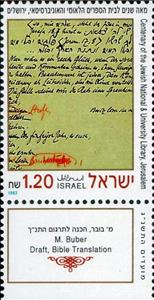Stamp with Collectible Margin: Draft of Translation by Martin Buber of Leviticus 25: 10-13 (Israel 1992)
Draft of Translation by Martin Buber of Leviticus 25: 10-13 (Israel 1992)
17 September (Israel ) within release Festival 1992 goes into circulation Stamp with Collectible Margin Draft of Translation by Martin Buber of Leviticus 25: 10-13 face value 1.20 Israeli new shekel
| Stamp with Collectible Margin Draft of Translation by Martin Buber of Leviticus 25: 10-13 in catalogues | |
|---|---|
| Michel: | Mi: IL 1238T |
| Stamp Number: | Sn: IL 1123T |
| Yvert et Tellier: | Yt: IL 1183T |
| Stanley Gibbons: | Sg: IL 1183T |
Stamp with Collectible Margin is square format.
Also commemorates the Centenary of Jewish National and University Library, Jerusalem.Also in the issue Festival 1992:
- Stamp with Collectible Margin - "Parables" (Yitzhak ben Shlomo ibn Sahula) face value 85;
- Stamp with Collectible Margin - Draft of Translation by Martin Buber of Leviticus 25: 10-13 face value 1.20;
- Stamp with Collectible Margin - Mahzor (prayer book) face value 1;
Stamp with Collectible Margin Draft of Translation by Martin Buber of Leviticus 25: 10-13 it reflects the thematic directions:
An anniversary is the date on which an event took place or an institution was founded in a previous year, and may also refer to the commemoration or celebration of that event. For example, the first event is the initial occurrence or, if planned, the inaugural of the event. One year later would be the first anniversary of that event. The word was first used for Catholic feasts to commemorate saints. Most countries celebrate national anniversaries, typically called national days. These could be the date of independence of the nation or the adoption of a new constitution or form of government. The important dates in a sitting monarch's reign may also be commemorated, an event often referred to as a "Jubilee".
A festival is an event celebrated by a community and centering on some characteristic aspect or aspects of that community and its religion or cultures. It is often marked as a local or national holiday, mela, or eid. A festival constitutes typical cases of glocalization, as well as the high culture-low culture interrelationship. Next to religion and folklore, a significant origin is agricultural. Food is such a vital resource that many festivals are associated with harvest time. Religious commemoration and thanksgiving for good harvests are blended in events that take place in autumn, such as Halloween in the northern hemisphere and Easter in the southern.
The New Year is the time or day at which a new calendar year begins and the calendar's year count increments by one. Many cultures celebrate the event in some manner. In the Gregorian calendar, the most widely used calendar system today, New Year occurs on January 1 (New Year's Day, preceded by New Year's Eve). This was also the first day of the year in the original Julian calendar and the Roman calendar (after 153 BC)



